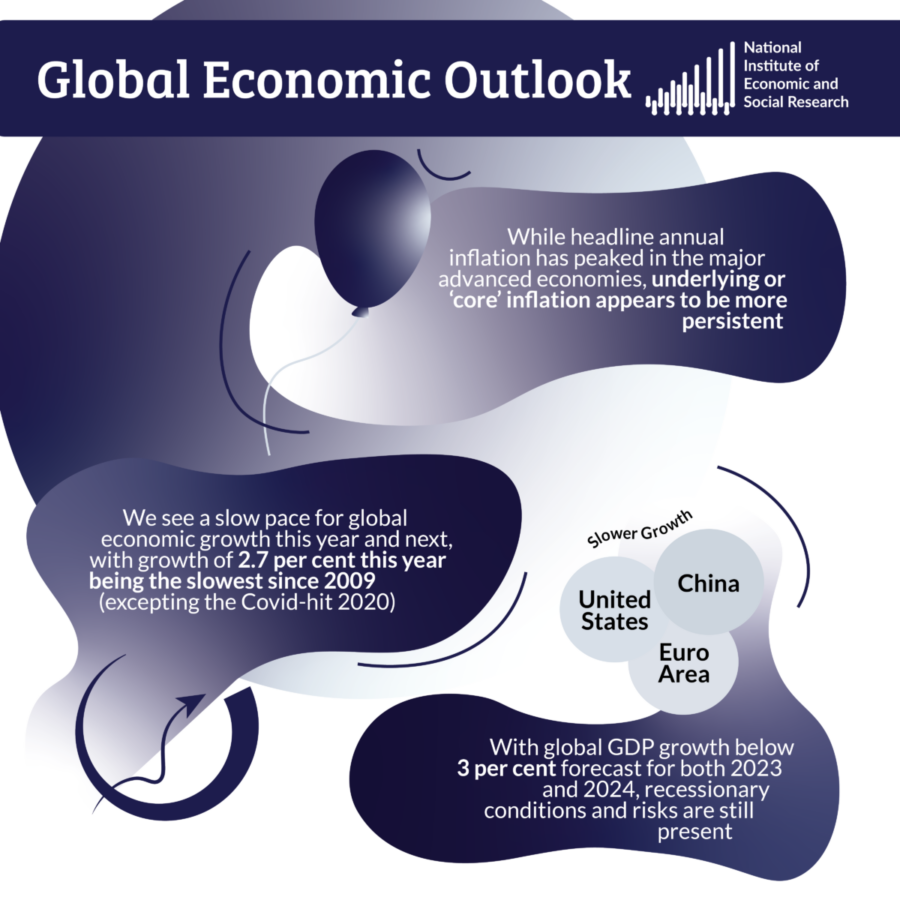Global Growth Stalls as Rate Rises Bite
While headline annual inflation has peaked in the major advanced economies, underlying or ‘core’ inflation appears to be more persistent. Inflation increased rapidly in advanced economies following the price and supply shocks created by Russia’s war in Ukraine, but energy and commodity prices have fallen back, offering the prospect of lower headline inflation.
Sign in to Access Pub. Date
Pub. Date
09 August, 2023
 Pub. Type
Pub. Type

Main points
- We forecast that OECD annual consumer expenditure deflator inflation will fall from 10.9 per cent last year to 5.4 per cent in 2024 as the effects of lower oil and commodity prices feed through and economic activity grows at a below trend pace. OECD inflation is not expected to return to its pre-pandemic average annual rate (of 1.9 per cent for 2015-19) in the short run.
- We see a slow pace for global economic growth this year and next, with growth of 2.7 per cent this year being the slowest (excepting the Covid-hit 2020) since 2009. The slow pace of growth is expected to continue into 2024 as the lagged effects of monetary policy tightening in the advanced economies weigh on the overall picture. Growth again below 3 per cent is forecast, with our view unchanged from our Spring Outlook.
- With global GDP growth below 3 per cent forecast for both 2023 and 2024, recessionary conditions and risks are still present. GDP in the Euro Area has fallen, albeit marginally, for two successive quarters, with more substantial falls in its major economy, Germany, over the same period. The pace of quarterly GDP growth in the United States is likely to fall back in the second quarter and quarterly GDP growth in China was markedly slower in the second than in the first quarter of this year. The ending of Covid lockdown in China has boosted economic activity, particularly in East Asia but worrying downside risks for activity, particularly in the manufacturing sector, remain. Outside the major advanced economies, the outlook is somewhat stronger but with continued uncertainty.
- We continue to expect that this year will see the peak in policy interest rates in the major advanced economies. The rapid increase in policy rates over the past fifteen months is starting to bite in terms of slower growth, risks of recession and falling inflation. While the reductions in oil and commodity prices will reduce annual headline inflation in advanced economies, the monetary authorities will be watching to see how underlying inflation progresses. We continue to expect it to be more persistent than headline inflation but we do expect it to reduce.
- Central banks will be mindful of risks of financial fragility following the bank failures in the United States, particularly as higher interest rates hit borrowers. We assume that the Federal Reserve (Fed) have reached their peak interest rate and that the European Central Bank (ECB) increases the rate on its main refinancing operations to 4.5 per cent this year.
- Monetary policymakers are likely to look for a sustained fall in inflation (especially in underlying inflation) before they consider reducing rates, even if recessionary conditions start to prevail. Our market-based assumptions show central banks in advanced economies starting to reduce rates in early 2024, reflecting the stubbornness in underlying inflation. If underlying inflation falls more rapidly than we expect, policy rates could too. However, there is a possibility that policymakers will worry about the perception of their being too slow to loosen policy in the face of falling inflation and weakness in economic activity, the reverse of their being seen as having been too slow to tighten monetary policy in 2021, and may be tempted to reduce rates earlier.






















